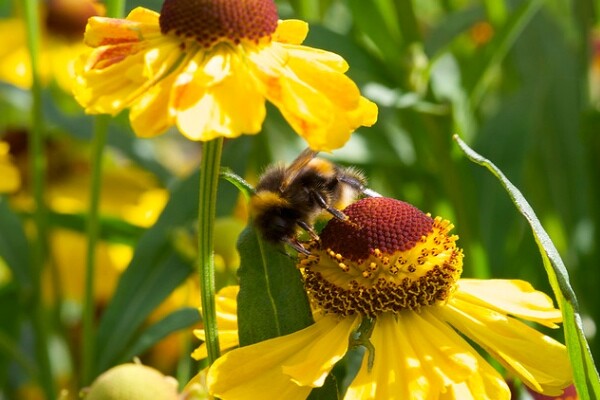Celebrate National Pollinator Week

Everyone remembers their first bee sting.
For me, it was on a family trip when I was 11 years old. (I can date it accurately because my friend's dad was exhaustively playing Bruce Springsteen's newest album "Human Touch.") I was climbing a rock wall near a river, trying to get a good grasp on my hold, when all of a sudden what felt like a sharp point of the rock stuck me in my ring finger. I withdrew, forced myself to complete the climb, and by the time I was at the top of the landing my finger was the size of a bratwurst.
I hated bees that day, and for some time after. It's a common feeling among youngsters who have suddenly been exposed to a creature that can cause that much pain. And unfortunately, it's a fear that not a lot of people grow out of. (Watch any grown adult who's just had their ear buzzed by a bee for proof.) The problem is that, instead of fearing bees, we need to learn their importance and help protect them. Which is the goal of National Pollinator Week, which started on Monday and runs through the end of the week.
The biggest thing to understand about pollinators is just where they fit into our own lives. You see, like the rest of us mammals, plants like flowers, cucumbers, and melons need to have certain parts from a male and certain parts from a female in order to reproduce. However, unlike the more mobile lifeforms on the planet, the only way for the male bits and pieces to get into the female bits and pieces is with a little assistance from the outside. Enter: The pollinating creatures that go from plant-to-plant, bringing with them the plant baby-making material.
But, you probably already knew that, so how about some other vital facts about pollinators:
- 75% of all flowering plants need the help of pollinators to fertilize.
- An estimated 1/3rd of all of the food and beverages that we consume is, in some way, affected by pollinators.
- If you're a monetarily-focused individual, maybe you'd be interested in learning that pollinators contribute $20 billion annually in products to our nation's GDP.
And the worst fact of all:
- Over the past year, nearly half of all honey bee hives in the U.S. have been destroyed to the continuing mysterious disaster that is "Colony Collapse Disorder." This is the highest percentage in recent memory.
Meaning, if there's one thing to take away from National Pollinator Week, it's that bees might not be as active as usual. One way to help, then, is by taking a walk to your local garden and checking:
Check to see if bees are pollinating your plants by looking for them in the morning hours. If you see bees, there you go. If you don't, Agrella has a helpful tip to pollinate them yourself: "Take a Q-Tip and swirl it into the opening of the male flower, and then swirl the same Q-Tip in the female flower. You should see fruit. The same can be done with a soft paintbrush, or even by just picking off one of the male flowers and sticking it in the female flower manually.
But National Pollinator Week doesn't simply begin and end with bees. Other pollinators that need to get some recognition include birds, bats, beetles, and the lovely butterflies. As far as that last one goes, in honor of National Pollinator Week, tickets to the Butterfly Pavilion at Rancho Santa Ana Botanical Garden are only two bucks a pop. There, folks of all ages can walk through the butterfly habitat to learn all about their pollinating ways.
If you can't make it, or if live in a non-garden-adjacent part of the asphalt jungle, you can still help. Shoot out a link to this post. Tweet out a few pollinator facts to your friends. Spread the word about CCD and what's triggering it. Maybe even hold a themed potluck dinner where all of food comes from pollinators.
If none of these are striking your fancy, head on over to Pollinator.org for some more ideas. The point is, this week is National Pollinator Week. So, let's get on out there and spread the word about pollinating!


